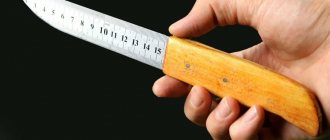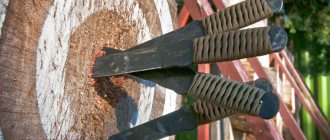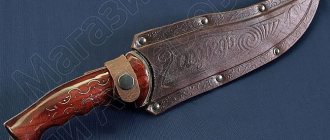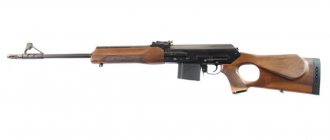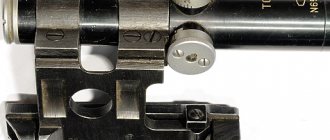The Yakut knife is a traditional weapon of the northern Sakha peoples, having a blade length of 110-170 mm (on average) and a wooden handle. The blade is made of mild steel, it is used for hunting and fishing, so you need the ability to sharpen/edit “in field conditions.” Yakut knives have varieties: for children and women with a blade length of 80-110 mm, a sword with a length of 500 mm and others. It is not a bladed weapon and can be purchased and used without special permission.
Real Yakut knives sell for 3 thousand rubles and more.
Main characteristics of the Yakut knife: size, shape
The Yakut knife has an individual size and original shape, therefore it is considered a unique product. Moreover, its parameters have been preserved since ancient times and have not undergone any fundamental changes.
| Characteristic | Short description |
| Blade length | 110-170 mm (most common shape) |
| Blade sharpening | Asymmetrical, one-sided |
| Blade shape | Convex, on the opposite side there is a valley |
| Blade material | Mild steel for the ability to quickly edit/sharpen the knife in the field |
| Handle length | 130-150 mm |
| Sheath | Required attribute |
Story
The history of Yakut knives has no beginning; no written evidence or even drawings of this type of weapon have been preserved. Researchers believe that the Yakuts in ancient times used imported metal to make weapons, although there is also a version that the people themselves could smelt the necessary material from ore.
And the fact that imported metal was most often used is confirmed in documentary records from 1978 - at that time folklore data about the peoples of Yakutia was collected.
It is reliably known that the original shape of the blade is a prototype of the bones of large animals (in ancient times they acted as a chopping, cutting, piercing tool).
We recommend reading the article about throwing knives. From it you will learn about the types and shapes of throwing knives, where you can throw knives and how to make a throwing knife yourself. And here is more information about the Nepalese Kukri knife.
Is it a bladed weapon?
Yakut knives of various types are not edged weapons; they belong to the category of household tools and are used for woodworking, fishing, hunting and other needs. In Soviet times, there was a legal ban on the manufacture, carrying and use of Yakut knives without special permission. In fact, such an element of the peoples of the North was simply not paid attention to.
Yakut knives are a mandatory element of the national costume; they are used by every representative of the fishing people of the regions of the Far North.
Features of the blade
Features of the blade include variability in its length:
- the most common sizes are 110-170 mm;
- for children and women – 80-110 mm;
- a large knife, can be used as a full-fledged military weapon, therefore it is made extremely rarely - from 170 mm.
They also make another version of the Yakut knife - “batyya”, which is a full-fledged sword with a blade length of 500 mm, having the same curved shape as a standard tool, and an asymmetric sharpening.
The blades also differ in width:
- tundra - characterized by a narrow blade;
- alas/taiga – the blade is wide.
The first option is convenient for use during hunting, fishing, herding a herd of deer; a tundra knife is used to cut and drill holes in wooden blanks. The taiga tool is used for cutting carcasses of hunted animals (or domestic animals) and as a cutter for woodworking.
Yakut knife “Takzhny”
Yakut knife “Tundra”
Much controversy arises regarding the appearance of the fuller on the blade: some researchers believe that it is necessary for quickly cutting frozen meat and blood flow, others are confident that the fuller was made to lighten the weight of the knife (this made it convenient for long-term use and prevented it from drowning) .
Sheath
For a Yakut knife, the sheath is a mandatory attribute, which is also distinguished by its originality. Historically, they are made from oxtail skin, which is removed in a single stocking. A wooden spacer is inserted inside, but there should not be a tight fit of the blade. This sheath design is not associated with the need to hold the weapon; the Yakuts simply protect the steel of the blade from breakage.
Reliable storage of the knife in the sheath is ensured by the size of the sheath - it hides 2/3 of the weapon and fits tightly to the handle.
Modern sheath models are made of genuine leather (regardless of what part of the animal it comes from); there are options for birch bark or wood. The scabbard is worn on the belt and attached to it with a loop.
Watch the video on how to make a sheath for a Yakut knife:
Handle
According to ancient tradition, the knife handle is made of birch burl, which is pre-impregnated with oil. The shape is simple; there is no guard or any other stops. In cross-section, the handle is identical to the egg, its sharp end (narrowed) is directed towards the blade. The standard length of the handle is 130-150 mm - this is much wider than a man’s palm, which makes it convenient to use, and such a weapon will not sink.
The material for making the handle of a Yakut knife can be not only birch burl, but also birch bark - its fragments are first put on the shank of the blade, then overlapped, and fixed together with glue.
The weapons of the peoples of Yakutia, whose handles are made of plastic or mammoth bone, belong to the category of souvenirs.
What steel?
The traditional Yakut knife is distinguished by soft steel - such a blade will be convenient to sharpen even in “field conditions”, when you have to make do with stones and pebbles. But modern manufacturers are already offering consumers tools made of harder steel and even Damascus - this is practical, interesting, but is not the true weapon of the peoples of Yakutia.
4 types of steel for a Yakut knife
Where it was used and is used today
Previously, the traditional Yakut knife was used:
- when hunting - they used it to cut up the carcasses of hunted animals;
- while fishing - cutting ropes and nets;
- while staying in the tundra - the knife is suitable for cutting and processing thin tree branches, cutting moss and other needs.
Today, such cutting tools are often used for household needs: cooking (in particular cutting planed meat), woodworking, making hunting snares and fishing gear.
What is a Yakut knife like?
The Yakut knife comes in different modifications, the main difference is the length of the blade, but the quality characteristics remain unchanged.
Batu
Batu (batyya) is the most massive Yakut knife, the blade length is 500 mm. This model can be used both as a spear and as a sword. The peoples of the north rarely use it, mainly in the tundra or taiga, because with its help you can:
- cut a clearing in a dense thicket;
- cut branches for the fire;
- catch fish in the river (if you have experience with a spear);
- cut into pieces a large carcass of hunted game.
Watch the video about the Yakut knife Batuya:
Bychakh
The blade length of the Yakut knife called bychakh is 110-170 mm, and these are the most common parameters. Even modern Yakut men who are not professional fishermen have such weapons. The knife is used for any housework and hunting/fishing.
They are as comfortable as possible:
- cook food - he is excellent at peeling vegetables and cutting meat;
- clean thin tree twigs for making vines;
- cut nets, ropes, cables and so on.
Yakut knife bychakh
Khotokhon
Among the classic Yakut knives there is also a military weapon - the khotokhon, the blade of which is 170 mm long. Historically, the northern Sakha peoples rarely fought, so this instrument was not used often. But it was held in high esteem by hunters and fishermen, who spent long periods of time fishing in the tundra and taiga - the long blade allowed them to protect themselves from wild animals.
Modern khotokhon is exclusively a souvenir product and therefore, despite the fact that the parameters clearly correspond to the definition of “edged weapon,” it can be stored and purchased without special permission.
Yakut souvenir knife khotokhon
Other brand knives
Among other branded knives in Yakutia, the “bychycha” stands out, which is distinguished by a short blade - 80-110 mm. It is optimally suited for use by women; it is convenient for them to work in the kitchen - deboning meat, cutting food, including bread. Bykhycha is also used in household work - installing a yurt, cutting ropes, and so on.
This same small Yakut knife is given to children. Among the northern peoples, mastery of such an instrument is considered mandatory; the first skills are acquired at the age of 5 years and older.
Yakut knife bykhycha
Varieties
The family of Yakut knives includes several types; the main criterion for their difference is the length of the blade:
- Bykhycha is a small knife, 80-110 mm in size, which, due to anthropometric data, is used more by children and women.
- Bychakh is a blade measuring 110-170 mm, used by men to cut the carcass of a killed animal, as well as to perform household tasks.
- Khotokhon is a knife more than 170 mm in length, previously used as a combat knife, but currently less common.
- Batuya is a very large knife, about half a meter long. This specimen looks more like a sword, but has all the same characteristic features of a Yakut.
The most popular today is the bychakh - a universal knife with optimal size and weight.
Bykhych
Bychakh
Khotokhon
Batuya
How to wear a Yakut knife
The Yakut knife is worn on the belt on the right or left, the location depends on which hand the person has working (right-handed/left-handed). The instrument must be in a sheath; it has a loop on top, which is the locking element.
Yakut knives are not used for combat, so there is no need to ensure their quick removal - the sheath is closed like a strap.
How to make a Yakut knife with your own hands, what is needed for this
To make a Yakut knife with your own hands, you will need:
- file – source material, you need to find a Soviet-made one;
- metal rod;
- a furnace or the possibility of lighting an open fire;
- sledgehammer weighing 1500 g;
- the hammer is small, weighing a maximum of 600 g;
- machine oil, technical;
- emery wheel;
- sandpaper;
- felt circle.
These tools will be needed to make the blade. The handle is best made from hardwood.
Home making process
Algorithm for making a Yakut knife at home:
- Saw off a piece of the required length from the file. The parameters depend on the exact size of the tool needed.
- Weld a metal rod to the sawn edge.
- Heat the workpiece in a forge or over an open fire. As soon as the steel stops reacting to the applied magnet, the process stops.
- Using a sledgehammer weighing 1.5 kg, the blade is “pulled out”. You need to knock on the hot metal often, constantly turning the workpiece from one side to the other.
- Use a sledgehammer to form a shank from a welded metal rod.
- Forge the slopes on the blade. During this stage, the blade will begin to bend, but this is normal - the geometry will subsequently be restored.
- The dol (“bloodstock”) is made with a piece of metal rod, which is applied to the workpiece. The structure needs to be warmed up a little in a forge or over an open fire. Then the dol itself is tapped with a light hammer, after which the rod is simply removed.
- Align the blade in a common plane. As a result, it should be slightly curved and have a sharp tip.
- Dipping the workpiece into boiling industrial oil is hardening the metal. Hardening time - 1 hour, temperature - 200 degrees.
- On an emery wheel, excess metal (sagging) is removed and the plane of the blade is brought out.
- Sanding - first with 1200 sandpaper (fine-grit), then with a felt wheel.
Watch the video on how to make a Yakut knife yourself:
The final part of the work is making the handle. It is better to use an apple tree for this. The work consists of cutting out a rectangular block with a hole into which the shank is inserted and filled with glue. Next, the handle is ground on a grinding machine and decorated with carvings as desired.
Sharpening a Yakut knife for right-handed and left-handed people
Another feature of the Yakut knife is the possibility of sharpening for right-handed and left-handed people: if a person has a “working” right hand, then sharpening work is carried out to the right of the fuller (respectively, for a left-handed person - to the left). The sharpening stone is applied to the cutting edge strictly at an angle of no more than 5 degrees.
The blade is sharpened with movements from top to bottom - from the butt to the edge, the process continues until a thin shiny line appears on the blade. In the Yakut language it is called “kylaan” and is the sharpest part of the knife.
You cannot sharpen a Yakut knife on an electric sharpener; they are prohibited from turning over the coals or simply heating the blade. These actions lead to tempering, which will make the metal soft and make it impossible to work with the tool.
We recommend reading the article about German bayonet knives. From it you will learn about famous products of German bayonet knives from the Second World War, the characteristics of the Mauser 98k bayonet knife, as well as how much a German bayonet knife costs and where you can buy it. Here's more information on how to choose the best switchblade.
Yakut knives are easy to use, they are not classified as edged weapons, and are successfully used in the kitchen, around the house, and in hunting/fishing.
Blade making
The most common practice is to make Yakut knives from old Soviet files - the metal is good, and the shape fits well. And at the preparatory stage, you will need to carry out only two actions with this workpiece: cut a piece of the required size and weld a rod to it.
The further order of work is a little more complicated:
- The file is slowly heated until the metal loses its magnetic properties (yes, a magnet for the first test is much better than guessing the temperature by color).
- The next stage is forging. For these purposes, a four-kilogram sledgehammer is well suited, which will have to forge the workpiece until it reaches a thickness of 2-3 mm along the entire length. We remember that the cooled workpiece needs to be heated to the optimal temperature in the forge (now you can navigate by the color that was during the first heating).
- After reaching the desired thickness, it is the turn of the shank and the leading edge, after the formation of which the slopes can be forged. The latter is not necessary if you prefer to form them using sandpaper.
- Now it’s the turn of the main highlight - the big dol. It is most convenient to hammer it with the sharp side of a one and a half kilogram hammer.
- Almost finished: leveling, normalization in oil, tempering and checking for cracks.
To carry out the latter, you can place a blade on two parallel bars (after release) and step on it. True, the help of a lightweight friend may come in handy, since the workpiece must withstand a weight of 60–70 kg; its strength will not be enough for more (or it will be enough, but it’s not worth the risk).
If the test was successful, you can begin the most exciting activities - sanding, grinding and polishing.

